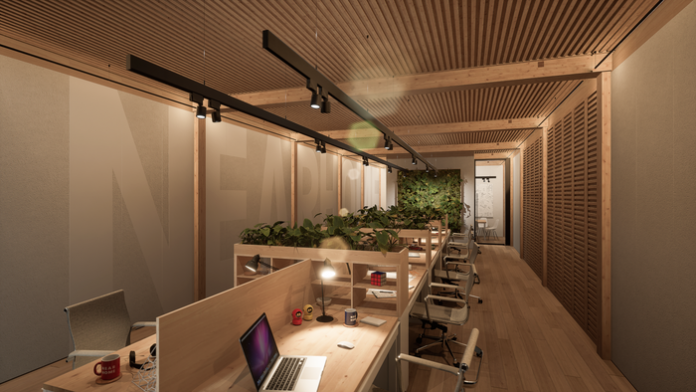Construction Scotland Innovation Centre (CSIC) has revealed new plans to help retrofit public spaces into out-of-town alternatives to city centre offices, reflecting the changing working patterns of a post-Covid Scotland.
As part of the NearHome project, supported by £250,000 in Scottish Government funding, a team of construction, sustainability, office design, and technology experts have developed a blueprint for a self-build, modular approach to office fit out using a kit that can be replicated and adapted to different types and sizes of buildings.
South Lanarkshire Council and Smart Sustainable East Kilbride are also supporting the initiative, with input from infrastructure experts, the Scottish Futures Trust. The plans are designed to align with the emerging 20-minute neighbourhood approach to city planning that has gained momentum during the pandemic.
The toolkit, which will be freely available to businesses and construction firms, centres around a kit-of-parts structure that can be installed quickly and with minimal interference for the building’s external fabric. It will also offer a solution for buildings that may have previously been considered too difficult or costly to retrofit.
Sustainability is also a core element of the design, with a kit made from Scottish timber that can be easily deconstructed and re-used if required. Increased use of homegrown timber – across all areas of construction – could have a significant impact on the sector’s carbon footprint by reducing the reliance on imported materials and making the most of natural resources.
Lynsey Brydson, innovation manager at CSIC, said: “Covid-19 has caused a significant shift in working patterns and this approach to office design could be transformational in providing commuters with an alternative to heading into the city centre for work. Retrofitting is one of the biggest challenges when it comes to improving the carbon footprint of our built environment, but this sustainable approach is designed with low carbon materials and can be applied to older or unused buildings which would typically not be considered for office space.
“Using modern methods of construction, the design is easily replicated with the majority of the building work done in a quality-controlled, offsite environment. Throughout this initial stage of the project, we have already seen the benefits of collaboration, with multiple partners helping to create the design for an optimum work environment.”
NearHome office costs are designed to be in line with typical fit-out spend, with added benefits in terms of sustainability and a design fit for the future workforce. A variety of experts were consulted as part of the project including workplace designers, lighting specialists, acoustic engineers and Internet of Things (IoT) consultants, as well as a professor of immunology from Edinburgh Napier University who provided guidance on minimising Covid-19 risks.
A pilot test site is currently being identified in East Kilbride, which will be transformed into the first office space to be constructed based on the design.
Cabinet Secretary for Net Zero, Energy and Transport Michael Matheson said: “For those who can work from home, the COVID-19 pandemic will likely create a longer-term shift in working and travel patterns. If harnessed, it can be beneficial for local communities, our environment and in supporting Scotland’s world leading target of net zero emissions target by 2045.
“Working from quality spaces closer to home can offer greater flexibility and work-life balance, whilst reducing transport emissions and creating local economic opportunities – which is all part of the Scottish Government’s ambition for 20-minute neighbourhoods.
“That’s why we’re investing £250,000 to support the NearHome project by the Construction Scotland Innovation Centre. Sustainable building practices coupled with modular designs will offer flexible applications in many existing buildings – enabling retrofitting and reuse over new building projects. I look forward to seeing how the toolkit benefits building retrofitting projects across Scotland.”















